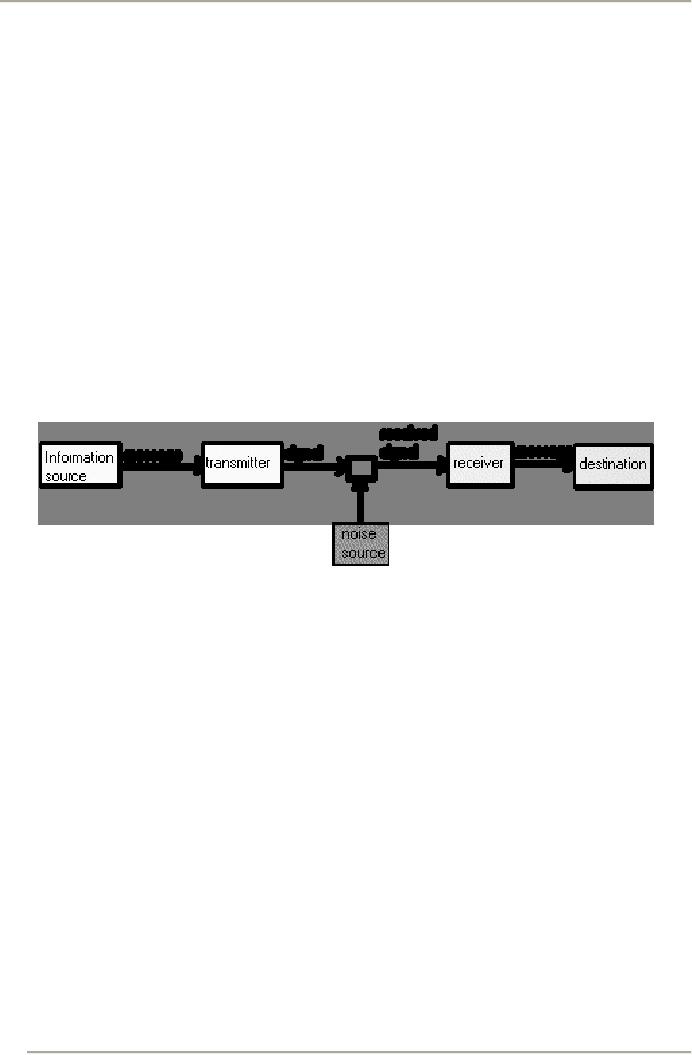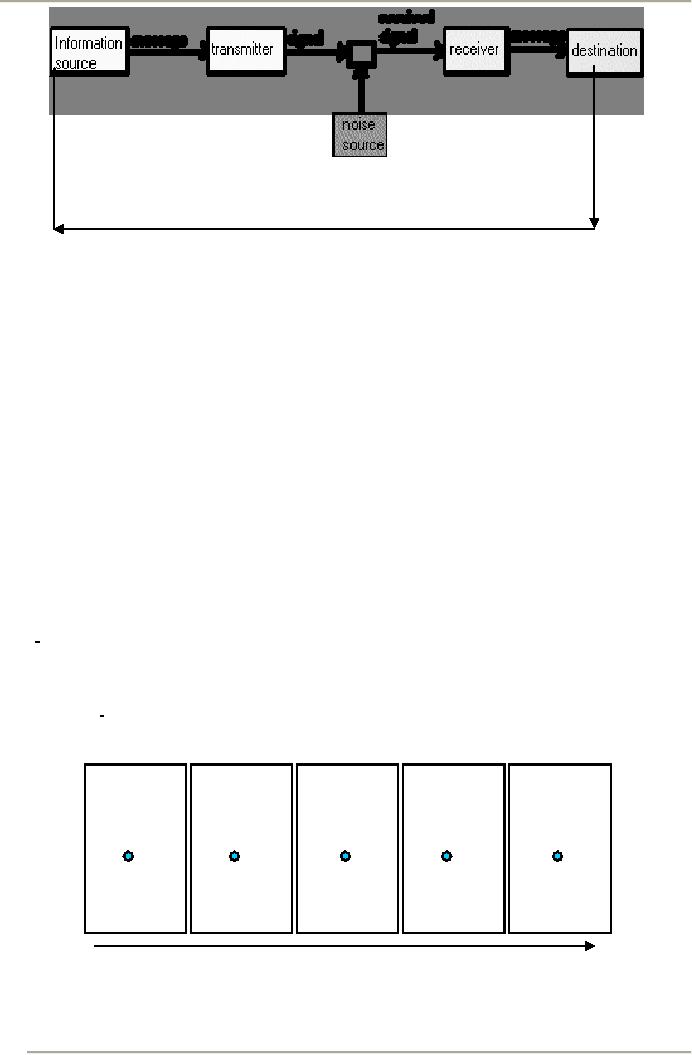 |
ELEMENTS OF COMMUNICATION AND EARLY COMMUNICATION MODELS |
| << SEVEN CENTURIES OF MASS COMMUNICATION – FROM PRINTING TO COMPUTER |
| COMMUNICATION MODELS – GRAPHIC PRESENTATION OF COMPLEX ISSUES >> |

Introduction
to Mass Communication MCM
101
VU
LESSON
04
ELEMENTS
OF COMMUNICATION AND EARLY COMMUNICATION
MODELS
Like
all the complex objects, communication is
also made up of certain
basic things called
elements.
A
building has its elements in
brick, sand, cement, iron,
wood, paints and sanitary
fittings. A machine has
a
number
of components which are all
elements joined together to enable the
machine to give desired
results.
Communication
is a complex business and involves
certain elements which join
together to help a message
go
across.
In
this chapter we will give a long
sight to various elements
which have been marked by
experts and which
provide
the very basics of any piece of
communication however simple it may
be.
Elements
of communication
Sender
First
and foremost is the person who
sends a message. Known as
sender in the jargons of
communication,
he or she is the chief initiator of any
communication. In fact a communication may
not
take
place if there is no sender.
The sender may be singular
and plural as well. It all
depends on the nature
of
communication. If a teacher is delivering
lecture, it constitute a case of sender
as one individual.
Sender
comprising
many is the case when a
group of people shout together, or more
than one person sing a
song
as
chorus.
Message
When
sender the source of communication,
decides to communicate he/she
encodes the crux of
the
feeling in words/gestures or any other
form commonly understood. This encoded
form is called
message.
It may be a simple word or a very complex
and technical integration of
feelings by the source on a
given
subject.
Channel
No
sooner a message is created by a
sender, it enters in the channel.
The channel is part of
the
communication
process which helps carry
the message to its desired destination.
In case of printed
words
paper
is the channel, in the matter of voice air
may serve as a channel. In telephonic
conversation the wire
and
the sets make the channel.
Some times the channel
itself becomes part of
message and sometime
message
is sent in a manner that a
part of it serves as a
channel.
Receiver
The
process of communication may not be
complete if the message does
not reach a person,
or
persons,
it is designed for. Receiver in this
process is the element which is
target of the message and
actually
receives
it. The dimension of receiver is very
wide it may vary from an individual
to an army of people, or
a
nation or all nations.
Again, it depends what the message
is.
Interpreter
Receiving
message in most case is half
the process of communication done. In
most cases an
interpreter
is required to understand decode the
message so that the purpose of
communication is
served.
Noise always occurs at this
stage. Noise means part of
meaning which is lost from the
original
message.
There is hardly a message which is
decoded, or interpreted cent
per cent.
Feedback
Sending
and receiving of message is a
simultaneous process in which the
receiver continuously
sends
back its approval or disapproval after having
interpreted the message. This helps the
sender to modify
or
discipline its message. This
element in the communication process is referred as
feedback. For instance
a
person
is delivering speech, the voices,
gestures and facial
expressions all part of
feedback, would help
the
speaker
to check its loudness,
smiles, rhetoric, contents or time to
speak. If there is no feedback, the
original
message
may never shape accordingly
which may distort the whole communication
exercise.
Context
8

Introduction
to Mass Communication MCM
101
VU
Every
message is delivered and received in a
given context. Change in the background
factors
denoted
as context, may change the meanings
altogether. Context itself comprises
multiple factors each
one
of
them becomes essential when it
comes to interpretation of the original
message.
Communication
Model
Communication
experts have long been
striving to arrange elements of
communication into some
graphic
arrangement so that all the complexities
of communication may come in view in a
glance. But
before
we try to examine them lets
try to understand what a model
is.
What
is a Model?
�
A model is a
systematic representation of an object or event in
idealized and abstract form.
Models
are
somewhat arbitrary by their
nature.
�
Communication
models are merely pictures;
they're even distorting pictures,
because they stop or
freeze
an essentially dynamic interactive or transitive
process into a static
picture.
�
Models
are metaphors. They allow us
to see one thing in terms of
another.
The
Shannon-Weaver's Model of
Communication
The
Shannon-Weaver's model is typical of what are
often referred to as transmission models
of
communication.
Claude Shannon and Warren
Weaver were two different
entities that jointly produced a
model
known after their
names.
Claude
Shannon and Warren Weaver produced a
general model of communication:
This
model is now known after them as the
Shannon-Weaver's Model. Although they
were principally
concerned
with communication technology,
their model has become one
which is frequently introduced
to
students
of human communication early in their
study.
The
Shannon-Weaver's Model (1947)
proposes that all communication
processes must include following
six
elements:
�
Source
�
Encoder
�
Message
�
Channel
�
Decoder
�
Receiver
These
six elements are shown
graphically in the model. As Shannon was
researching in the field of
information
theory, his model was
initially very technology-oriented. The model
was produced in 1947.
The
emphasis here is very much on the
transmission and reception of
information. 'Information' is
understood
rather differently from the way
you and I would normally
use the term, as well. This model
is
often
referred to as an 'information
model' of
communication.
Apart
from its obvious technological
bias, a drawback from our
point of view is the model's
obvious
linearity.
It looks at communication as a one-way process. A
further drawback with this
kind of model is
that
the message is seen as relatively unproblematic. It is
fine for discussing the
transformation of
9

Introduction
to Mass Communication MCM
101
VU
'information'
but when we try to apply the model to
communication, problems arise with the
assumption
that
meanings are somehow
contained
within the
message.
Detailed
analysis of the
model
The
Source
All
human communication has some
source
(information
source in
Shannon's terminology),
some
person
or group of persons with a given
purpose, a reason for
engaging in communication. You'll also
find
the
terms transmitter
and
communicator
used.
The
Encoder
You,
as the source, have to express
your purpose in the form of a
message. That message has to
be
formulated
in some kind of code. How
do the source's purposes get
translated into a code? This
requires an
encoder. The
communication encoder is responsible for
taking the ideas of the source
and putting them in
code,
expressing the source's purpose in the
form of a message.
In
person-to-person communication, the encoding process is performed
by the motor skills of the source
-
vocal
mechanisms (lip and tongue
movements, the vocal cords, the lungs,
face muscles etc.), muscles
in the
hand
and so on. Some people's
encoding systems are not as
efficient as others'. So,
for example, a
disabled
person
might not be able to control
movement of their limbs and so find it
difficult to encode the intended
non-verbal
messages or they may communicate
unintended messages.
A
person who has suffered
throat problem may have
had their vocal cords
removed. They can encode
their
messages
verbally using an artificial
aid, but much of the
non-verbal messages most of us
send via pitch,
intonation,
volume and so on cannot be
encoded.
Shannon
was not particularly concerned
with the communication of meanings. In
fact, it is Wilbur
Schramm's
model of 1954 which
places greater emphasis on the
processes of encoding and
decoding. We
will
discuss threadbare Schramm's model in
next lecture with special
emphasis on the provision of
interpretation
of a message for a logical understanding of what
has been sent by the source
originally.
The
Message
The
message of course is what communication is
all about. Whatever is communicated is
the
message.
Denis
McQuail (1975) in his book
Communication
writes
that the simplest way of
regarding human
communication
is 'to consider it as the sending
from one person to another of meaningful
messages'.
The
Shannon-Weaver's Model, in common with
many others separates the
message from other
components
of the process of communication. In reality,
though, you can only
reasonably examine the
message
within the context of all the
other interlinked elements.
Whenever we are in contact
with other
people
we and they are involved in
sending and receiving
messages. The crucial question
for
Communication
Studies is: to what extent does the
message received correspond to the
message
transmitted?
That's where all the other
factors in the communication process come
into play.
The
Shannon-Weaver's model and others
like it tends to portray the
message as a relatively uncomplicated
matter.
Note that this is not a
criticism of Shannon since
meanings were simply not his
concern:
Frequently
the messages have meaning
that
is they refer to or are correlated
according to some system
with
certain
physical or conceptual entities.
(These considerations are
irrelevant to the engineering
problem).
The
Channel
The
words channel
and
medium
are
often used interchangeably, if slightly
inaccurately. The
choice
of the appropriate channel is a vitally
important choice in communication. It's
obvious that you
don't
use
the visual channel to communicate
with the blind or the auditory
channel with the deaf, but
there are
more
subtle considerations to be taken
into account as well.
10

Introduction
to Mass Communication MCM
101
VU
Physical
noise
Shannon
is generally considered to have
been primarily concerned
with physical (or
'mechanical' or
'engineering')
noise in the channel, i.e. unexplained
variation in a communication channel or random
error
in
the transmission of information. Everyday
examples of physical noise
are:
�
A
loud motorbike roaring down
the road while you're trying to hold a
conversation.
�
Your
little brother standing in
front of the TV set.
�
Mist
on the inside of the car
windscreen.
�
Smudges
on a printed page.
�
'Snow'
on a TV set.
It
might seem odd to use the
word noise in this way. In this
technical sense, 'noise' is
not necessarily
audible.
Thus a TV technician might
speak of a 'noisy picture'. However, it
is possible for a message to
be
distorted
by channel
overload.
Channel overload is not due to
any noise source, but rather
to the channel
capacity
being exceeded. You may come
across that at a party where
you are holding a conversation
amidst
lots
of others going on around you or,
perhaps, in a communication lesson where
everyone has split
into
small
groups for
discussion.
Shannon
and Weaver were primarily
involved with the investigation of technological
communication. Their
model
is perhaps more accurately referred to as
a model of information
theory
(rather than communication
theory).
Consequently, their main
concern was with the kind of
physical (or mechanical)
noise discussed
above.
Transfer
of a mismatch between the encoding and
decoding devices to the study of
human communication
and
you're looking at what is normally referred to as
semantic
noise That
concept then leads us on to
the
study
of social class, cultural background,
experience, attitudes, beliefs
and a whole range of other
factors
which
can introduce noise into
communication.
Semantic
noise
Semantic
noise is not as easy to deal
with as physical noise. It
might not be an exaggeration to
say
that
the very essence of the study of human
communication is to find ways of avoiding
semantic noise.
Semantic
noise is difficult to define. It may be
related to people's knowledge level,
their communication
skills,
their experience, and their
prejudices and so on. It all
depends on the commonality of experiences
on
part
of the receiver to understand message
from sender.
The
Decoder
The
notion of a decoder reminds us
that it is quite possible
for a person to have all the
equipment
required
to receive
the
messages you send (all five
senses, any necessary technology
and so on) and yet
be
unable
to decode
your
messages.
The
Receiver
For
communication to occur there must be
somebody at the other end of the
channel. This person
or
persons can be called the
receiver. To
put it in Shannon's terms,
information transmitters and
receivers
must
be similar systems. If they are
not, communication cannot occur.
(Actually Shannon used the
term
destination,
reserving the term receiver
for
what we have called decoder.
What
that probably meant as far
as he was concerned was that
you need a telephone at one
end and a
telephone
at the other, not a telephone connected
to a radio. In rather more obviously
human terms, the
receiver
needs to have the equipment to receive
the message. A totally blind
person has the mental
equipment
to decode your gestures, but
no system for receiving messages in the
visual channel. So,
your
non-verbal
messages are not received
and you're wasting your
energy.
1949
Shannon- Weaver's Model of
Communication
11

Introduction
to Mass Communication MCM
101
VU
Feedback
Feedback
Feedback
is a vital part of communication. In the
class room students' facial
expression tell the
teacher
to go to what extent to make students
understand the point under discussion.
More or less, these
expression
would guide the teacher
where and when to
finish.
When
we are talking to someone
over the phone, if they don't give us the
occasional 'mmmm', 'aaah',
'yes, I
see'
and so on, it can be very
disconcerting. In face-to-face communication, we
get feedback in the
visual
channel
as well - head nods, smiles,
frowns, changes in posture and
orientation, gaze and so
on.
Why
do people often have difficulty
when using computers, when they
find it perfectly easy to drive a
car?
You'd
think it should be easier to operate a
computer - after all there are
only a few keys and a
mouse, as
against
levers, pedals and a
steering wheel. A computer's
not likely to kill you,
either. It could be due to the
lack
of feedback - in a car, you've the sound
of the engine, the speed of the landscape
rushing past, the
force
of gravity. Feedback is coming at you
through sight, hearing and
touch -overdo it and it
might come
through
smell as well. With a computer, there's
very little of that. In fact you apply
more of your brain as
what
you must be doing next
rather than shaping your
activity whether it's being liked or not
by the
machine.
Feedback
by definition
In
its simplest form the
feedback principle means
that a behavior is tested
with reference to its
result
and success or failure of this
result influences the future
behavior
Though
not exactly cut-out for
human communication, the Shannon-Weaver model provides
clear
guidelines
for researchers to mark more
avenues for graphic presentation of the
elements in daily
human
communication.
Lasswell
Formula (1948)
To
Whom?
Who?
Says
What?
In
What
With
what
Effect?
Channel?
Communicator
Message
Channel
Receiver
Effect
Effects
Control
Content
Medium
Audience
Research
Research
Research
Research
Research
The
sociologist, Harold Lasswell,
tells us that in studying communication we should
consider the elements
in
the graphic above.
12

Introduction
to Mass Communication MCM
101
VU
Lasswell
was primarily concerned with
mass communication and propaganda, so
his model is intended to
direct
us to the kinds of research we need to conduct to
answer his questions
('control analysis',
'effects
research'
and so on). In fact, though, it is
quite a useful model, whatever
category of communication we are
studying.
Note, incidentally, that the
Lasswell Formula consists of five major
components, though this is by
no
means obligatory.
Harold
Lasswell (1948) conceived of
analyzing the mass media in
five stages: "Who?" "Says
what?" "In
which/what
channel?" "To whom?" "With what effect?"
In apparent elaboration on Lasswell
and/or
Shannon
and Weaver, George Gerbner
(1956) extended the components to include
the notions of
perception,
reactions to a situation, and message
context.
13
Table of Contents:
- MASS COMMUNICATION – AN OVERVIEW:Relationships, Power
- EARLY MASS COMMUNICATION AND PRINTING TECHNOLOGY
- SEVEN CENTURIES OF MASS COMMUNICATION – FROM PRINTING TO COMPUTER
- ELEMENTS OF COMMUNICATION AND EARLY COMMUNICATION MODELS
- COMMUNICATION MODELS – GRAPHIC PRESENTATION OF COMPLEX ISSUES
- TYPES AND FORMS OF COMMUNICATION:Inter personal, Combination
- MESSAGE – ROOT OF COMMUNICATION I:VERBAL MESSAGE, Static Evaluation
- MESSAGE – ROOT OF COMMUNICATION II:Conflicts, Brevity of Message
- EFFECTS OF COMMUNICATION:Helping Out Others, Relaxation
- COMMUNICATION AND CULTURE:Enculturation, Acculturation
- LANGUAGE IN COMMUNICATION:Polarization, Labeling, Static meanings
- STEREOTYPING – A TYPICAL HURDLE IN MASS COMMUNICATION:Stereotype Groups
- MASS MEDIA – HISTORICAL PERSPECTIVE:Early analysis on manuscripts
- EMERGENCE OF PRINT MEDIA AROUND THE WORLD:Colonial journalism
- TELEGRAPH DOES MIRACLE IN DISTANCE COMMUNICATION TELEX AND TELEPHONE ENTHRALL PRINT COMMUNICATION
- TYPES OF PRINT MEDIA:Newspapers, Magazines, Books
- PRESS FREEDOM, LAWS AND ETHICS – NEW DEBATE RAGING STILL HARD
- INDUSTRIALIZATION OF PRINT PROCESSES:Lithography, Offset printing
- EFFECTS OF PRINT MEDIA ON SOCIETY:Economic ideas, Politics
- ADVERTISING – HAND IN HAND WITH MEDIA:Historical background
- RENAISSANCE AND SCIENTIFIC REVOLUTION: ROLE OF PRINT MEDIA:Science
- RECAP:Elements of communication, Books, Printing, Verbal Message
- MEDIA MANAGEMENT:Division, Business section, Press
- IMAGES IN MASS COMMUNICATION – INVENTION OF PHOTOGRAPHY:Portrait photography
- MOTION PICTURES – A NEW WAY IN MASS COMMUNICATION-I:Definition
- MOTION PICTURES – A NEW WAY IN MASS COMMUNICATION (Cont...):Post-Studio Era
- FILM MEDIA IN SUBCONTINENT AND PAKISTAN-I:Accusations of plagiarism
- FILM MEDIA IN SUBCONTINENT AND PAKISTAN (II) & ITS EFFECTS:First Color film
- PROPAGANDA:Types in another manner, Propaganda in revolutions
- RADIO – A BREAKTHROUGH IN MASS COMMUNICATION:What to broadcast
- EFFECTS OF RADIO ON SOCIETY:Entertainment, Information, Jobs
- TELEVISION – A NEW DIMENSION IN MASS COMMUNICATION:Early Discoveries
- TV IN PAKISTAN:Enthusiasm, Live Broadcast, PTV goes colored
- EFFECTS OF TELEVISION ON SOCIETY:Seeing is believing, Fashion
- PUBLIC RELATIONS AND MASS COMMUNICATION - I:History, Case Study
- PUBLIC RELATIONS AND MASS COMMUNICATION - II:Audience targeting
- ADVERTISING BEYOND PRINT MEDIA:Covert advertising
- IMPACT OF ADVERTISING:Trial, Continuity, Brand Switching, Market Share
- MEDIA THEORIES:Libertarian Theory, Social Responsibility Theory
- NEW MEDIA IN MASS COMMUNICATION:Technology forcing changes
- GLOBALIZATION OF MEDIA:Media and consumerism, Media centralization
- MEDIA MERGENCE:Radio, TV mergence, Economic reasons
- MASS MEDIA IN PRESENT AGE:Magazine, Radio, TV
- CRITICISM ON MEDIA:Sensationalize, Biasness, Private life, obscenity
- RECAP:Legends of South Asian Film Industry, Radio, Television, PTV goes colored